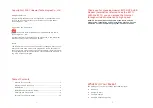
Telegesis (UK) Limited
TG-ETRXn-UG-01-103
7
User Guide
1.04
ETRX1 and ETRX2
©2008 Telegesis (UK) Ltd
ETRXn User Guide (Rev 1.04)
An alternative way to search the PAN for other modules is t
o hit the “Configure” button. As well as
scanning the PAN as before, it adds extra buttons to control the buzzer and LEDs on each remote
module.
Depending on the previous usage of your development kit, units may either immediately
communicate with each other on the same PAN, or they may be off-line. If the unit connected to
your PC does not report that it has joined a PAN within a few seconds of power-up, a suitable
procedure would be:
1. issue the command AT+JN to join any existing PAN or
2. issue the command AT+PANSCAN followed by AT+JPAN:<channel>,<PAN ID> to find and
join a specific PAN or
3. Wait for the module to automatically join a PAN as described in section 3.1.
4. If the steps above do not reveal an existing PAN, issue the command AT+EN to initiate a
new PAN. Others units searching for a PAN will then attach to it within a few minutes, and
be reported with a “NEWNODE:<EUI64>” prompt.
A common problem occurs when the user establishes a PAN and waits for the other devices to join
it … and waits … and waits. This usually means the the other devices are already in a PAN of
their own (set up when they were last used), and as long as they can communicate amongst
themselves they will ignore the new network. If you disassociate the local node and use the
AT+PANSCAN or AT+JN command, this will reveal the pre-existing PAN; you can join it and then
either carry on using it or disassociate the remote nodes and start afresh.
In order to find out which of the detected modules is which,
press the “Ident Node” button in the
“Test Commands” section of the buttons. This command requires an additional parameter,
therefore instead of sending a command straight to the local node the command is displayed in the
command bar with the te
xt “<Enter Parameter here>” highlighted.
Figure 5. Entering parameters
Now, double click on any entry in the “Discover Devices” window and the serial number of the
selected device will be added as a parameter. The command is executed by either pressing
“Enter”, or by clicking the “Send” button.
When executing this command the local module will send a request to the module with the
specified serial number asking it to identify itself. A module can identify itself by playing a tune on
a buzzer which is connected to I/O3. If you are using the devkit and you do not hear a tune check
that the jumper for I/O3 is set so that I/O3 is an output (factory default); on the MCBs the buzzer is
directly connected to I/O3.
Having identified which module is which you can now give each module a name using the
Telegesis Terminal software. To do this,
right click on the entry in the “Discover Devices” window
(as shown in Figure 6) and enter the name when prompted to do so. Please note that this name is
not written to the module itself, it only represents a temporary name which can be used to simplify
the evaluation process using the Telegesis Terminal software.








































